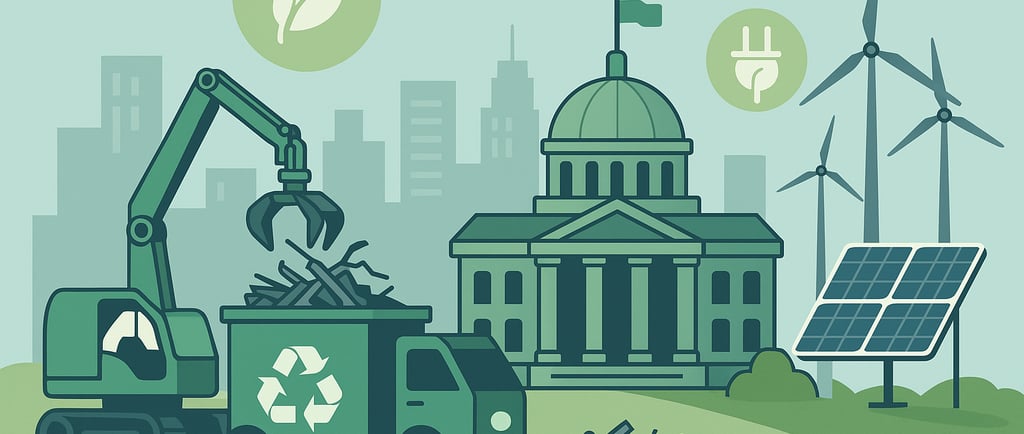Top Government Policies Driving Metal Recycling & Sustainability
Discover the key government policies and recycling laws shaping metal sustainability. Learn how legislation and green initiatives are transforming the future of waste management practices globally.
SCRAP METAL TRADE & POLICY


Introduction
In 2025, the global recycled metal market is projected to reach $75.5 billion, driven by sustainability mandates, technological advancements, and rising demand in sectors like construction and electric vehicles 25. Governments are doubling down on policies to accelerate the transition to a circular economy, with metal recycling at its core.
Key 2025 Developments:
The EU’s Critical Raw Materials Act (CRMA) now mandates 20% recycled content in critical metals by 2030, with €4 billion allocated for urban mining infrastructure 12.
The U.S. recycled scrap metal market is forecast to grow by 6.4% in 2025, fueled by Inflation Reduction Act (IRA) tax credits and the Buy Clean Initiative 25.
India’s Hazardous Waste Rules (2024) take effect in April 2025, requiring 5% recycled content in non-ferrous metals and introducing tradable EPR certificates 6.
Why Government Policies Matter in Metal Recycling
Metal recycling remains a linchpin for climate action, with policies addressing:
Energy savings: Recycling aluminum saves 95% energy vs. primary production, critical for net-zero goals 16.
Economic incentives: Tax breaks and carbon pricing (e.g., Canada, Australia) make recycled metals 20–30% cheaper than virgin materials 15.
Supply chain security: Over 40% of copper scrap is imported by China, highlighting reliance on global trade—a risk mitigated by local recycling mandates 6.
Landmark Government Policies Promoting Metal Recycling
European Union: Circular Economy Action Plan (CEAP) & Critical Raw Materials Act (CRMA)
2025 Target: Steel recycling rates hit 88% in 2024, with CRMA requiring 20% recycled critical metals (lithium, cobalt) by 2030 12.
Case Study: Belgium’s Metallo Group supplies 15% of EU’s recycled copper, supported by €200 million in smelting grants 1.
United States: Inflation Reduction Act (IRA) & Buy Clean Initiative
2025 Impact: Recycled aluminum production grew 22% since 2022, with $6 billion in IRA tax credits for clean energy projects 2.
Tech Innovation: Novelis’ $200 million zero-waste plant in Kentucky aims to cut 1 million tons of CO₂ annually 2.
Japan & South Korea: Extended Producer Responsibility (EPR) Overhauls
2025 Metrics: Japan’s e-waste recycling rate reached 84% in 2023, while South Korea’s POSCO reduced primary steel production by 12% via hydrogen-based furnaces 2.
Emerging Economies: India’s Scrap Policy & Brazil’s Reverse Logistics
India: Recycled steel output surged 18% YoY in 2024, reducing iron ore imports by $1.2 billion 2. New 2025 rules mandate 5% recycled content in non-ferrous metals 6.
Brazil: Reverse Logistics Law (2024) recycled 96,000 tons of lead-acid batteries in 2023, avoiding 500,000 tons of CO₂ 2.
Global Collaboration: Basel Convention Amendments
2025 Trend: Cross-border scrap trade grew 14% in 2023, reaching $500 billion, driven by streamlined non-hazardous scrap rules 2.
2025 Regulatory Trends Reshaping the Industry
1. Carbon Pricing Mechanisms
Canada and Australia now tie carbon taxes to primary metal production, making recycled alternatives 30% cheaper 15.
2. Digital Material Passports
The EU and Japan pilot blockchain systems to track metal origins, ensuring compliance with recycling quotas and reducing contamination risks 13.
3. Urban Mining Expansion
$10 billion invested globally in recovering metals from e-waste, with firms like Aurubis AG leading in AI-driven sorting 58.
4. Green Steel Subsidies
Governments fund hydrogen-based steel recycling to phase out coal furnaces. ArcelorMittal’s acquisition of John Lawrie Metals (2024) aims to cut CO₂ emissions by 50% 24.
5. Simpler Recycling in England
Starting March 2025, businesses must adopt 4-container systems (food, residual, paper, mixed recyclables) to end the “postcode lottery” and boost recycling rates 3.
Conclusion
In 2025, government policies are not just shaping—they are accelerating—the metal recycling revolution. From the EU’s CRMA to India’s EPR certificates, legislation is closing the loop on waste while unlocking $149.9 billion in market value by 2035 5. Key takeaways:
Tech-driven efficiency: AI sorting and XRT systems are cutting processing costs by 25% 58.
Global collaboration: The Basel Convention amendments are streamlining scrap trade, with Asia-Pacific leading 6% CAGR growth 7.
Circular economy wins: Recycled metals now account for 72.5% of ferrous scrap demand, driven by construction and EVs 58.
For businesses, 2025 is the year to treat recycling as a strategic advantage, not a compliance cost. For policymakers, the focus must shift to enforcing EPR frameworks and funding R&D for low-carbon smelting.
